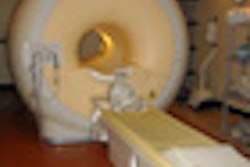The CT slice wars are sooo last year. Welcome to the tesla wars. Case in point: The University of Illinois at Chicago (UIC) recently trumpeted its new 9.4-tesla MRI system for head scans, calling it "the world's most powerful MRI (scanner) for decoding the human brain." But UIC's claim to that title may be short-lived, as a current project sponsored by the French atomic energy commission, and administered by Neurospin, promises an 11.7-tesla MRI system!
Many contemporary clinical and research sites are still wrestling with the adoption pains of popularly available 3-tesla systems. For them, these new technologies may seem well beyond the horizon. If contemporary MR systems can produce high-quality diagnostic images, why the rush to greater field strengths?
While the UIC's and Neurospin's advanced systems may seem closer to the realm of science fiction than to clinical reality, their efforts provide us with a glimpse into the near future of MRI -- just as the current clinical scanners give us a deeper view into the mysteries of our own bodies.
Clinical MR imaging depends largely on the magnetic susceptibility of hydrogen atoms. Since our bodies are made up mostly of bound water, there is ample hydrogen in virtually all locations in our bodies to produce viable anatomical images. But at higher field strengths, MR could use other atomic structures, most notably sodium, to unveil previously unseen levels of detail.
As appealing as the promise of new anatomical information is, the value of higher and higher field strength MR is not limited to anatomical imaging, as functional MRI (fMRI) and MR spectroscopy (MRS) have demonstrated. Many believe that these glimpses at functional and metabolic processes are only the tip of the iceberg in terms of the knowledge about processes within our bodies.
Even without throwing open new windows on metabolic functions, the signal-to-noise ratios of higher field strengths would allow for higher quality imaging or significantly reduced scan times. Imagine ultrarapid, pizzicato gradients for systems producing clinical models in a fraction of the time that current MR units are capable of doing. A 7-tesla clinical MRI scanner might be capable of scanning patients nearly as quickly as CT scanners at current levels of image resolution.
An argument against higher field strength systems is that they are more challenging (and expensive) to site and maintain. Vendors are diligently working on making the current cutting-edge systems easier to site. The new 3-tesla scanner by Siemens Medical Solutions of Malvern, PA, promises magnetic fringe field dimensions comparable to its 1.5-tesla scanner. This and similar efforts from other vendors will further diminish the perceived "premium" for siting higher-strength systems.
But the arguments against higher field strengths are likely moot. Unless these new systems uncover unanticipated hazards, MRI will continue the inescapable march toward higher field strengths. It would not be surprising to see 7-tesla scanners move beyond academic medical centers and take up residence in hospitals within 10 years.
By Robert Junk and Tobias Gilk
AuntMinnie.com contributing writers
January 29, 2008
Reprinted from www.mri-planning.com by permission of the authors. If you would like more information on any aspect of MR facility design or safety, please contact Robert Junk or Tobias Gilk at MRI-Planning.com.
Related Reading
Back to the present: VA updates MRI design guide, part II, December 5, 2007
Back to the present: VA updates MRI design guide, part 1, December 3, 2007
The million dollar question: How much should MRI suite construction cost? November 12, 2007
Total process management for efficient MRI suites, August 8, 2007
What does your MRI vendor know about your quench vent that you don't? July 3, 2007
Copyright © 2008 MRI-Planning



















